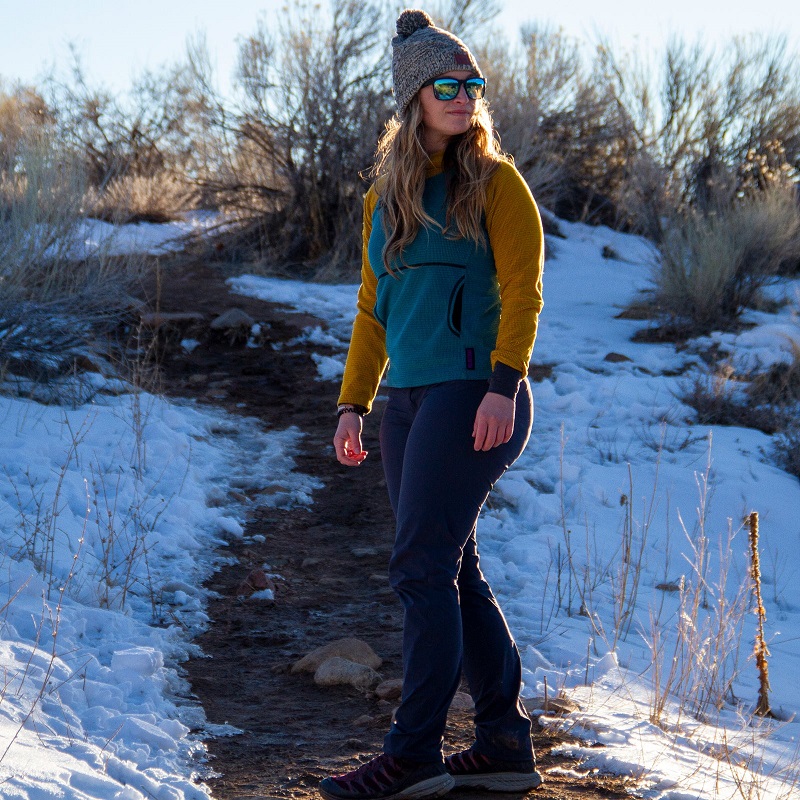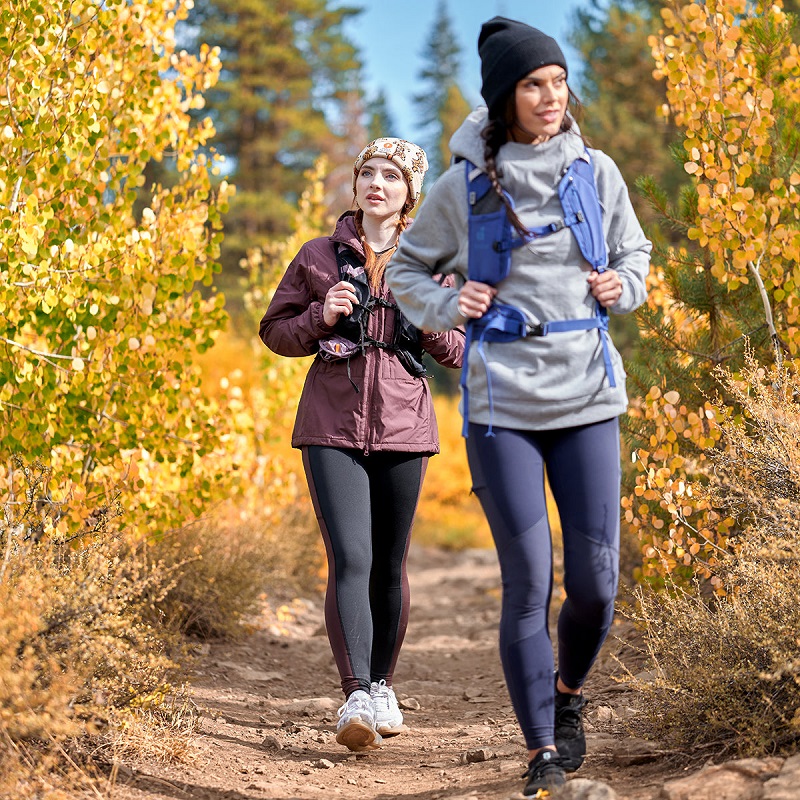What to wear when hiking? Hiking is a popular outdoor activity that allows people to explore the beauty of nature while getting some exercise. Whether it’s a leisurely stroll through a local park or a challenging trek up a mountain, it’s important to dress appropriately for the occasion. Wearing the right clothing and footwear can make all the difference in ensuring a comfortable and enjoyable hiking experience. In this article, we will discuss what to wear when hiking, including clothing, footwear, and other essentials.

Clothing
What to wear when hiking? When it comes to hiking, the key to staying comfortable is layering. This allows you to adjust your clothing according to the changing weather and your level of exertion. Start with a moisture-wicking base layer that will keep sweat away from your skin and help regulate your body temperature. Avoid cotton as it retains moisture and can leave you feeling cold and clammy. Instead, opt for synthetic materials like polyester or merino wool.
On top of your base layer
Add an insulating layer such as a fleece or a down jacket to keep you warm in cooler temperatures. This layer should be breathable and lightweight, allowing you to move freely without feeling weighed down. Finally, choose an outer shell that is waterproof and windproof to protect you from the elements. Look for a jacket with adjustable cuffs, a hood, and ventilation zippers for added comfort.
For your lower half, consider wearing hiking pants that are made from quick-drying and durable material. Look for features like articulated knees, a gusseted crotch, and reinforced patches to ensure mobility and durability. Alternatively, you can opt for zip-off pants that can be converted into shorts, providing versatility in varying weather conditions.
Footwear
Choosing the right footwear is crucial for a successful hiking trip. Your shoes should provide support, stability, and traction while also being comfortable for long periods of walking. When selecting hiking shoes or boots, consider the terrain you will be traversing. For easy to moderate trails, a lightweight hiking shoe with good ankle support may be sufficient. However, for more challenging terrain or backpacking trips, a sturdy pair of hiking boots with ankle support and a rugged sole is recommended.
It’s important to break in your hiking footwear before hitting the trail to avoid blisters and discomfort. Wear them around the house, on short walks, and gradually increase the duration and intensity of wear. Additionally, choose socks made from moisture-wicking material like merino wool or synthetic blends to keep your feet dry and reduce the risk of blisters.

Accessories
What to wear when hiking? In addition to clothing and footwear, there are several accessories that can enhance your hiking experience. A comfortable and well-fitted backpack is essential for carrying water, snacks, a first aid kit, and other essentials. Look for a pack with padded shoulder straps, a hip belt, and adjustable suspension to distribute the weight evenly and reduce strain on your back.
Other important accessories include a hat or cap to protect your face and eyes from the sun, a pair of sunglasses with UV protection, and sunscreen to shield your skin from harmful rays. In colder weather, bring gloves, a beanie, and a scarf to keep your extremities warm. Lastly, a hiking pole or trekking poles can provide stability and reduce the impact on your joints, especially on steep or uneven terrain.
How to choose hiking clothes
Hiking is a great way to get out and enjoy the beauty of nature while also getting some exercise. Whether you are a seasoned hiker or just starting out, having the right apparel is essential for a comfortable and enjoyable experience.
Consider the Weather
One of the most important factors to consider when choosing hiking apparel is the weather. The weather can change quickly when you are out on the trails, so it is important to be prepared for a variety of conditions. If you are hiking in hot, sunny weather, lightweight and breathable clothing is essential to help keep you cool and comfortable. Look for moisture-wicking fabrics that will help to keep sweat away from your skin. On the other hand, if you are hiking in cold or wet conditions, it is important to layer up with warm and waterproof clothing to protect yourself from the elements.
Choose the Right Fabric
When it comes to hiking apparel, the fabric of the clothing is crucial. Look for clothing made from synthetic materials such as polyester or nylon, as these fabrics are lightweight, breathable, and quick-drying. Avoid cotton clothing, as it tends to absorb moisture and can take a long time to dry, which can lead to discomfort and even hypothermia in colder weather.

Consider the Fit
The fit of your hiking apparel is also important for both comfort and functionality. Look for clothing that is not too tight or too loose, as this can restrict your movement and cause chafing. Moisture-wicking base layers should fit snugly to help move sweat away from your skin, while outer layers should have a looser fit to allow for layering and freedom of movement. Additionally, consider the length of your pants and sleeves to ensure they provide adequate coverage and protection from the sun, bugs, and brush.
Protect Yourself from the Sun
When spending extended periods of time outdoors, it is important to protect yourself from the sun’s harmful rays. Look for clothing with a UPF (Ultraviolet Protection Factor) rating, which indicates the level of protection the fabric provides against the sun. Additionally, consider wearing a wide-brimmed hat and sunglasses to protect your face and eyes, and don’t forget to apply sunscreen to any exposed skin.
Choose the Right Footwear
In addition to apparel, choosing the right footwear is also essential for a successful hiking trip. Hiking boots or shoes should provide good ankle support, traction, and protection from rocks and debris. Look for shoes with a sturdy sole and a waterproof or water-resistant upper, especially if you will be hiking in wet or rugged terrain. It is also important to break in your hiking footwear before hitting the trails to prevent blisters and discomfort.
Layer Up
Layering is key when it comes to hiking apparel, as it allows you to easily adjust your clothing to the changing conditions. Start with a moisture-wicking base layer to help regulate your body temperature and move sweat away from your skin. Add an insulating mid-layer for warmth, and finish with a waterproof and breathable outer layer to protect yourself from wind, rain, and snow. This layering system will help you stay comfortable and dry throughout your hike, no matter the weather.
Consider the Terrain
When choosing hiking apparel, it is important to consider the terrain you will be hiking on. If you will be hiking on rugged or uneven trails, consider wearing pants to protect your legs from scrapes and scratches. For more leisurely hikes on well-maintained trails, shorts may be a suitable option. Additionally, consider any specific hazards such as ticks, poison ivy, or other environmental factors that may require additional protection or precautions.
Accessorize Wisely
In addition to clothing and footwear, there are a few key accessories to consider when choosing hiking apparel. A good backpack is essential for carrying your gear, water, and snacks, so be sure to choose one that is comfortable and functional for your needs. Other important accessories include a hat, gloves, and a buff or neck gaiter to protect your head, hands, and neck from the elements. Finally, consider bringing along a pair of gaiters to keep debris out of your shoes and protect your lower legs in wet or snowy conditions.

Conclusion
What to wear when hiking? Wearing the right clothing and footwear is essential for a safe and enjoyable hiking experience. By layering your clothing, choosing appropriate footwear, and bringing along essential accessories, you can ensure comfort and protection while out on the trail. Remember to consider the weather, terrain, and duration of your hike when selecting your gear. With the right gear, you can focus on soaking in the beauty of nature and enjoying the great outdoors. Happy hiking!
